
A prostrate shrub is a woody plant, most of the branches of which lie upon or just above the ground, rather than being held erect as are the branches of most trees and shrubs.

A prostrate shrub is a woody plant, most of the branches of which lie upon or just above the ground, rather than being held erect as are the branches of most trees and shrubs.
Prostration may occur because the supporting tissues in stems are not strong enough to support the weight of the plant, causing the plant to bend until it reaches the ground. Alternatively, it may occur because of a genetic disposition for branches to grow horizontally on or just under the ground; for example, as a strategy to avoid overly strong sunlight. Finally, environmental factors such as strong winds laden with sand or salt may tend to prune away erect branches, thereby creating a prostrate habit in plants that may not be predisposed to prostration.
Prostrate shrubs are used in horticulture as groundcovers and in hanging baskets, and to bind soils and prevent erosion in remedial landscaping. They are also important components of rock gardens. The shrinking size of urban gardens has meant an increase in demand for and desirability of dwarf and prostrate forms of many garden plants. More recently, prostrate shrubs have received attention for their usefulness in planting green roofs and green walls, where they can contribute to environmental conservation.
Prostrate plant forms may arise from deliberate breeding and hybridisation, such as the groundcover grevilleas, including Grevillea "Poorinda Royal Mantle", [1] and G. "Bronze Rambler", [2] or by selection of forms of plants growing in exposed areas. The windswept coastal heathlands and cliffs of far southeastern New South Wales have yielded Banksia 'Roller Coaster' and Banksia 'Pygmy Possum'. [3] These are flattened varieties of less than 0.5 m in height of the species Banksia integrifolia and Banksia serrata , respectively, both of which grow to sizeable trees of 10 m (30 ft) or more in height. [3] The origin of others is unclear; Cootamundra Wattle ( Acacia baileyana ) is a popular and widely used garden plant in Australia, a prostrate form of which is also in cultivation. Its origin is unknown, possibly a chance seedling in cultivation. It itself is a popular garden plant, its cascading horizontal branches good for rockeries. [4]
Many species of roses grow as long canes that can spread prostrate on the ground, and some of these have been hybridized to form climbing and rambling roses that can be allowed to grow on the ground without support, as well as varieties known as "carpet roses" that are intended to be grown as ground covers. [5] Prostrate juniper, Juniperus communis subsp. alpina is a naturally occurring form of a popular evergreen. [6] Many species of Cotoneaster , such as C. apiculatus, are prostrate ornamentals, [7] as are the closely related Pyracanthas , and the humilis variant of sweetbox, Sarcococca hookeriana var. humilis. Heaths ( Erica carnea and related species) and heathers (Calluna vulgaris) are prostrate shrubs often featured prominently in rock gardens. [8] Wintergreens such as Gaultheria humifusa and Gaultheria procumbens are also prostrate growers. [9]
Although, strictly speaking, herbaceous, the North American bunchberry ( Cornus canadensis ), a member of the dogwood genus, can appear as a prostrate shrub when growing in the garden. [10] Many daphnes, particularly those derived from Daphne odora , are prostrate growers, including forms that are highly fragrant and have variegated leaves, although they are short-lived. [11] Some forms of the culinary herb rosemary (Rosmarinus officinalis) form prostrate shrubs when grown in Mediterranean climates, although they die back to the ground when grown where winters are colder. [12]
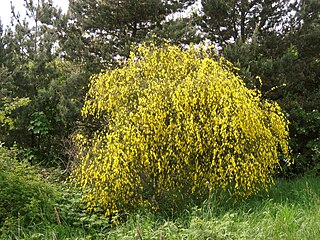
A shrub is a small-to-medium-sized perennial woody plant. Unlike herbaceous plants, shrubs have persistent woody stems above the ground. Shrubs can be either deciduous or evergreen. They are distinguished from trees by their multiple stems and shorter height, less than 6–10 m (20–33 ft) tall. Small shrubs, less than 2 m (6.6 ft) tall are sometimes termed as subshrubs. Many botanical groups have species that are shrubs, and others that are trees and herbaceous plants instead.
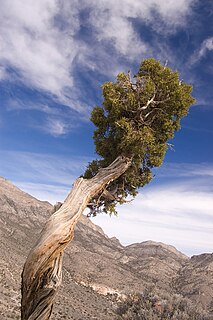
Junipers are coniferous trees and shrubs in the genus Juniperus of the cypress family Cupressaceae. Depending on the taxonomy, between 50 and 67 species of junipers are widely distributed throughout the Northern Hemisphere, from the Arctic, south to tropical Africa, throughout parts of western, central and southern Asia, east to eastern Tibet in the Old World, and in the mountains of Central America. The highest-known juniper forest occurs at an altitude of 4,900 metres (16,100 ft) in southeastern Tibet and the northern Himalayas, creating one of the highest tree lines on earth.

Groundcover or ground cover is any plant that grows over an area of ground. Groundcover provides protection of the topsoil from erosion and drought.
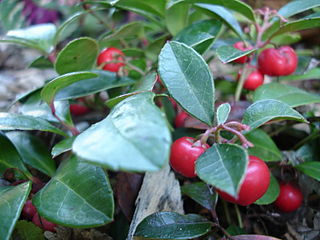
Gaultheria procumbens, also called the eastern teaberry, the checkerberry, the boxberry, or the American wintergreen, is a species of Gaultheria native to northeastern North America from Newfoundland west to southeastern Manitoba, and south to Alabama. It is a member of the Ericaceae.

Microbiota is a monotypic genus of evergreen coniferous shrub in the cypress family Cupressaceae, containing only one species, Microbiota decussata. The plant is native and endemic to a limited area of the Sikhote-Alin mountains in Primorskiy Krai in the Russian Far East. The name causes much confusion because of other meanings for the word "microbiota", but the genus name was derived from micro-, meaning "small", + Biota, the genus name for a closely related conifer, a species formerly called Biota orientalis, now renamed Platycladus orientalis.

Cornus sanguinea, the common dogwood or bloody dogwood, is a species of dogwood native to most of Europe and western Asia, from England and central Scotland east to the Caspian Sea. It is widely grown as an ornamental plant.
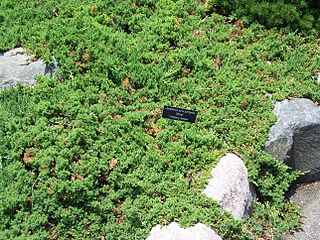
Juniperus procumbens is a species of shrub in the cypress family Cupressaceae, native to Japan. This low-growing evergreen conifer is closely related to the Chinese juniper, Juniperus chinensis, and is sometimes treated as a variety of it, as J. chinensis var. procumbens.

Juniperus squamata, the flaky juniper, or Himalayan juniper is a species of coniferous shrub in the cypress family Cupressaceae, native to the Himalayas and China.

Banksia petiolaris is a rare species of flowering plant in the family Proteaceae native to Western Australia, where it is found in sandy soils in the south coastal regions from Munglinup east to Israelite Bay. It was first described by Victorian state botanist Ferdinand von Mueller in 1864, and no subspecies are recognised. B. petiolaris is one of several closely related species that will all grow as prostrate shrubs, with horizontal stems and thick, leathery upright leaves. Those of this species can be viable for up to 13 years—the longest-lived of any flowering plant recorded. It bears yellow cylindrical flower spikes, known as inflorescences, up to 16 cm high in spring. As the spikes age, they turn grey and develop up to 20 woody seed pods, known as follicles, each.

Banksia blechnifolia is a species of flowering plant in the genus Banksia found in Western Australia. It was first described by Victorian state botanist Ferdinand von Mueller in 1864, and no subspecies are recognised. It gained its specific name as its leaves are reminiscent of a fern (Blechnum). B. blechnifolia is one of several closely related species that grow as prostrate shrubs, with horizontal stems and leathery, upright leaves. The red-brown flower spikes, known as inflorescences, are up to 20 centimetres (8 in) high and appear from September to November in the Australian spring. As the spikes age, each turns grey and develops as many as 25 woody seed pods, known as follicles.

The woodlands of the Iberian Peninsula are distinct ecosystems on the Iberian Peninsula. Although the various regions are each characterized by distinct vegetation, the borders between these regions are not clearly defined, and there are some similarities across the peninsula.
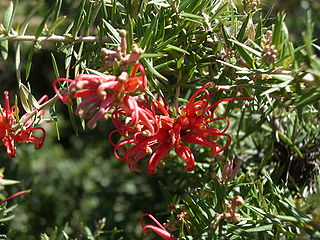
Grevillea juniperina, commonly known as juniper- or juniper-leaf grevillea or prickly spider-flower, is a plant of the family Proteaceae native to eastern New South Wales and southeastern Queensland in Australia. Scottish botanist Robert Brown described the species in 1810, and seven subspecies are recognised. One subspecies, G. j. juniperina, is restricted to Western Sydney and environs and is threatened by loss of habitat and housing development.

Grevillea curviloba is a species of flowering plant in the family Proteaceae and is endemic to the south-west of Western Australia. It is a prostrate to erect shrub with short branchlets, divided leaves with linear to narrowly lance-shaped lobes with the narrower end towards the base, and white to cream-coloured flowers.

Grevillea × gaudichaudii is a hybrid species of flowering plant in the family Proteaceae and is endemic to a restricted area of New South Wales. It is a prostrate shrub with deeply lobed leaves and toothbrush-like groups of dark pink to burgundy-red flowers. The plant is a popular garden ground-cover.
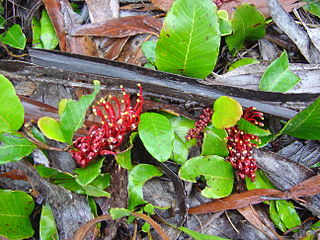
Grevillea laurifolia, commonly known as laurel-leaf grevillea, is a species of flowering plant in the family Proteaceae and is endemic to New South Wales. It is a prostrate, trailing shrub with egg-shaped, heart-shaped or round leaves, and clusters of reddish to deep maroon flowers.
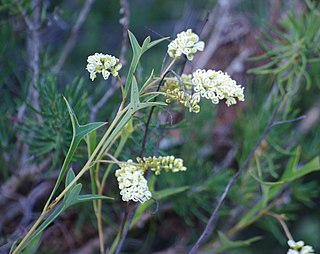
Grevillea synapheae, the catkin grevillea, is a shrub in the family Proteaceae. It is endemic to the southwest of Western Australia, occurring in low heathland.

Persoonia procumbens is a plant in the family Proteaceae and is endemic to part of the New England Tableland. It is a prostrate shrub with rather fleshy, relatively large leaves and small groups of cylindrical yellow flowers. It is similar to P. daphnoides but has darker hairs on the young branches and smaller, less hairy flowers.

Persoonia chamaepeuce, commonly known as the dwarf geebung or heathy geebung, is a plant in the family Proteaceae and is endemic to south-eastern Australia. It is a prostrate shrub with crowded, linear leaves and yellow flowers in the leaf axils.
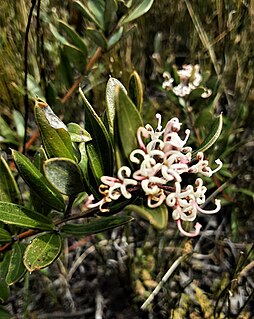
Grevillea imberbis is a species of flowering plant in the family Proteaceae and is endemic to eastern New South Wales. It is a prostrate to low, spreading shrub with egg-shaped to lance-shaped leaves with the narrower end towards the base, and white flowers, sometimes turning pink with age.